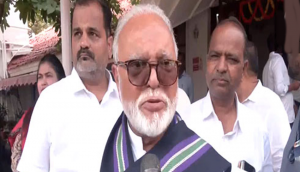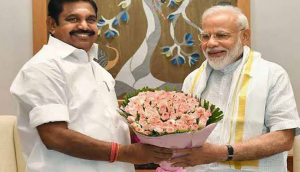Shivaji and the long search for a nationalist Hindu icon

Prime Minister Narendra Modi Saturday tweeted he was honoured for getting the opportunity to perform the 'bhoomipoojan' for the Shivaji statue scheduled to be set up in Mumbai.
He called the 17th century warrior king a "torch bearer of courage, bravery & good governance".
Chhatrapati Shivaji Maharaj is a torchbearer of courage, bravery & good governance. #ShivSmarak is a fitting tribute to him & his greatness.
— Narendra Modi (@narendramodi) December 24, 2016
I am honoured to be getting the opportunity to perform the Bhoomipujan of #ShivSmarak.
— Narendra Modi (@narendramodi) December 24, 2016
Keeping this in mind, it might be in order to figure out what sort of a warrior prince Shivaji actually was.
The victorious party always whitewashes history to suit its immediate interest, but occasionally to jog our memories and see some uncomfortable truths might be a good idea.
For Hindu nationalists during the post-independence age, Shivaji became the right icon to superimpose on the grand tales of Mughal valour and thus appropriate and reinvent a prince into a national Hindu icon.
The Mumbai statue-building, is part of this project. The second of the twin project is to reincarnate Sarvarkar.
Hundreds of Shivaji statue adorn places in central India and, as if all that was not enough, Lal Krishna Advani inaugurated a statue right in front of the Agra Fort in 2001 - where Shivaji was imprisoned by Aurangzeb - in an act of posthumous revenge.
There Advani proclaimed that the "great Maratha warrior was his ideal and the country needs a statesman like Shivaji who can lead it from the front."
A look at Shivaji's career as warlord, however, shows him up to be a bully and coward of high cunning and not a strong fighter the Mughals admired or feared.
He preferred plunder of unguarded territories rather than the rigours of battle.
Shivaji by all accounts was a natural warrior and by the age of 16 itself proved his wild nature his horsemanship and his daring.
It has been said that plundering was his main interest in his earlier years. But "as his power grew so did his vision," wrote Abraham Eraly in his modern classic Emperors of the Peacock Throne (Penguin) from which the following details are taken.
Only during the last phase did Shivaji consolidate his empire, which at its peak stretched from Daman to Ankola, nothing to match Mughal dominions but maybe just enough to be mythologised.
Shivaji has been characterised as undependable in battle or in peace. While it might be a viable strategy, the question of now building a statue to him in the high seas is actually a brazen attempt at whitewashing the character and acts of a warrior far removed from the Parivar's projected concepts of high morality, valour and national pride.
Shivaji, the man of great valour, would do anything to escape at the moment of defeat and often when he feared he might lose out to the Mughal or Bijapur armies he pleaded for mercy.
When such things never worked, Shivaji blamed his position on goddess Bhavani whose name he used often as a ruse to escape from Mughal commanders.
Once when Shivaji, fearing defeat, refused to turn up for battle, Aurangzeb's commander Dil Singh challenged him to "first fight and then seek peace", despite Shivaji's earlier boasts of having "strong forts, sky-kissing hills, abysmal ravines and brave soldiers lying in ambush." Shivaji opted out and just surrendered.
Shivaji also opted out of another confrontation against the Mughals who were raiding Bijapur. When Bijapur made a desperate plea to Shivaji to help them in battle, he heeded the call.
When he came within 38 kms of facing the Mughal army under Dilir Khan, he developed cold feet and "veered away to ravage the Mughal lands between Bhima and Godavari rivers," according to Eraly.
When he was returning with the loot he was intercepted by a Mughal army, lost 4,000 men in battle and surrendered the entire loot.
Shivaji fled, just about escaping a capture, using obscure paths and marched for three days and nights to make sure he was safe.
Finally, when he came for a meeting with Mughal commander Jai Singh in June 1665 he came like a penitent bowing in front of Jai Singh. "Shivaji then with a thousand signs of shame clasped his hands and said 'I have come as a guilty slave to seek forgiveness, and it is for you to pardon or kill me at your pleasure'."
If this is the true bravery which is now sought to be showcased in the Arabian Sea, Shivaji's various methods to get pardon from Aurangzeb is worth remembering at least to get a clear picture of the man.
Shivaji surrendered everything he had, including 23 forts in the Deccan to the Mughals. Worse, he had to release his son Sambhaji to the Mughal service at a salary or mansab of 5000.
Shivaji had no problems giving his son as hostage and pleaded that he himself should be excused from attending the Mughal court and sought pardon saying: "Hitherto I had no wisdom or prudence and have trodden the path of shortsightedness, I have not the face to wait on the emperor. exempt me from mansab and service."
Not satisfied having just said this, Shivaji continued pleading: "So long as I live, I shall not draw my neck back from obedience to orders of service. Whenever in your Deccan wars, I am appointed to any duty, I shall without delay perform it."
He then "begged hard for the full suit of the robe of honour" worn by Jai Singh who obliged and also gave him an elephant and two horses.
So this notion of a brave warrior who stood up to the Mughal might is a myth. In fact the Mughals toyed with him and Aurangazeb treated him like a small time problem and often send him robes of honour. The plan was to use him as an ally in the Mughal Deccan conquests, which he too was happy to be part of.
Soon after this dismal surrender Shivaji himself wrote to Aurangzeb. He often alternated between bravado and apology in all his dealings. "This offender and sinner ... hereafter will firmly be engaged in performing the Emperor's work as a reparation for his past life and an amendment of his uselessly spent days; he will never deviate from his position of rendering service, risking his life and carrying out the imperial mandates... He hopes that out of the storehouse of (your majesty's) grace life to this slave may be granted and an imperial firman may be issued pardoning his offences..."
Aurangazeb pardoned him and "granted all his prayers". A relieved Shivaji wrote another cloying letter to the emperor: "Shiva, the meanest of life-devoting slaves who wears the ring of servitude in his ear and the carpet of obedience on his shoulder (acknowledges) the good news of his eternal happiness namely favours from the Emperor... This sinner and evil doer did not deserve that his offences should be forgiven or his faults covered up. But the grace and favour of the Emperor have conferred on him a new life and unimaginable honour".
And when the combined Mughal and Shivaji army attacked Bijapur, Shivaji's performance was abysmal and his commander Netaji Palkar, deserted him and went to the other side and joined other Marathas serving Adil Shah.
So even then Marathas never held Shivaji in high esteem, a blot which is now sought to be whitewashed by installing a gleaming statue.
Basically his image is being reconstructed as a Hindu warrior who took on Mughal might. In this long effort, truth has been a casuality.
Shivaji was then forced to go to Agra to pay respects to Aurangazeb. The Mughals wanted to keep him out of their Deccan campaign since he was untrustworthy.
In Agra, Aurangazeb did not even talk to him and humiliated Shivaji who threw a fit and was thus put under 'house arrest' from where he escaped in a fruit and sweet basket, using high ingenuity.
Later Shivaji was to win more territories in the Deccan but his territory at its maximum was only around 300 square kilometres.
His basic character of valour and Maratha pride that the Maharasthra government and the parivar wants us to believe, is far from the truth.
His techniques may have been acceptable and the Mughals themselves were not far behind in such tactics. But here we are looking at a soldier who is sought to be deified.
Shivaji bribed Gopinath, a Bijapur envoy, who was a Brahmin and they ganged up to lure Afzal Khan, a Bijapur commander for a meeting. Shivaji while hugging him stabbed Khan in the back using a hidden weapon wagnuck (tiger claws).
Shivaji was a sudra but was transformed into a pretend-kshatriya (only they could be king) as was the convention.
The question is what values shown by Shivaji does the government want to honour or want the younger generation to imbibe by putting up his statue at a humungous cost.
This is why layers of interpretations has been pasted on to the persona of Shivaji, while the true man lies elsewhere.
Any attempt at giving the true picture of Shivaji has been blocked by various groups claiming to hold rights to Maratha pride.
Even Jawaharlal Nehru noted in 1934: "Some of Shivaji's deeds like the treacherous killing of the Bijapur general lower him greatly in our estimation." Later he was also forced to say that Shivaji was a great warrior and nationalist.
In 2004, American academic James Laine's book Shivaji: Hindu king in Islamic India (2003)was banned in Maharashtra. Later both the high court and the Supreme Court ordered lifting of the ban.
All parties support this imagined valour and bravery of Shivaji. Sure he had a lot going for him but modern day constructs of him by various Hindu organisations and all political parties are mostly myth.
In fact the greatest tribute to Shivaji came from Aurangzeb himself after his death: "My armies were employed against him for 19 years but nevertheless his State has always been increasing."
The statue will complete the myth-making project and a reinvented Hindu nationalist icon will gallop on his horse above the waves.
Views expressed here are the author's own
First published: 24 December 2016, 6:32 IST





![BJP's Kapil Mishra recreates Shankar Mahadevan’s ‘Breathless’ song to highlight Delhi pollution [WATCH] BJP's Kapil Mishra recreates Shankar Mahadevan’s ‘Breathless’ song to highlight Delhi pollution [WATCH]](https://images.catchnews.com/upload/2022/11/03/kapil-mishra_240884_300x172.png)

![Anupam Kher shares pictures of his toned body on 67th birthday [MUST SEE] Anupam Kher shares pictures of his toned body on 67th birthday [MUST SEE]](https://images.catchnews.com/upload/2022/03/07/Anupam_kher_231145_300x172.jpg)






